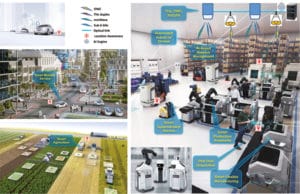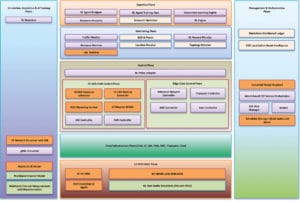The 6G BRAINS project vision

Yue Zhang
University of Leicester
Ubiquitous smart wireless connectivity is critical for future large-scale industrial tasks, services, assets and devices. Very significantly improved connectivity needs to be unlocked through novel spectrum combinations and the fully autonomous management of the underlying network resources by applying online Artificial Intelligence (AI) at multiple decision layers. Therefore, it is required to bring AI-driven Deep Reinforcement learning (DRL) to perform MAC/PHY resource allocation and configuration over the high dynamic ultra-dense D2D cell free (CF) network with new spectrum links including THz and optical wireless communications (OWC) to enhance the performance with regard to capacity, reliability and latency for next generation ubiquitous networks.
The 6G BRAINS project proposes a novel comprehensive cross-layer DRL driven resource allocation solution to support the massive connections over Device-to-Device (D2D) assisted highly dynamic cell-free network enabled by Sub-6 GHz/mmWave/THz/OWC and high-resolution 3D Simultaneous Localization and Mapping (SLAM) of up to 1 mm accuracy. The enabling technologies in 6G BRAINS focus on four major aspects, including disruptive new spectral links, highly dynamic D2D cell-free network modelling, intelligent end-to-end network architecture integrating the multi-agent DRL scheme and AI-enhanced high-resolution 3D SLAM data fusion. The proposed solution will be validated by proof-of-concept trials. The primary and secondary applications of THz and OWC technologies for a very broad spectrum of scenarios will be validated at BOSCH’s self-contained smart factory.

Figure 1: 6G BRAINS Concept Vision (images: Robert Bosch GmbH)
Enabling technologies
The enabling technologies in 6G BRAINS focus on four technological areas:
– Enhanced new spectrum links: OWC and THz
– AI-driven D2D cell free network architecture for highly dynamic and ultra-dense connectivity
– AI-based end-to-end directional network slicing with guaranteed QoS over highly dynamic networks
– AI-driven data fusion for 3D indoor position mapping through heterogeneous location methods enabling 1 mm location position accuracy and 1° orientation accuracy.
Factory of the future
The factory of the future represents one of the most challenging applications of the future mobile communication systems. A large number of specific use cases representing this scenario have been described in different bodies, including 3GPP and 5G-ACIA (5G Alliance for Connected Industries and Automation). From the large list of specific use cases in the factory of the future environment, 6G BRAINS identified two use cases which require further improvement of the current 5G technology.
The first use case represents the offloading of the control logic from the industrial controller running as part of a production cell on the shop floor to a more centralized computing area called “factory edge” in a virtualized form as a virtual machine or a container. A more centralized approach, where all controllers (real or virtualized) are placed in the same area will significantly increase the flexibility of the production process and reduce the cost. Connecting the production cells through the 6G BRAINS communication system to the “factory edge” shall enable the ease of reconfiguration of hardware and software components on demand. This use case sets very high expectations on the guaranteed latency and deterministic communication that should support low industrial application cycle times and very precise synchronicity.
Another use case is represented by wireless video cameras that are easily deployed in every factory production cell at different locations to send high-quality and high-frame-rate video to an image-analysing system located at the “factory edge”. By this, a new level of production monitoring is unleashed enabling a long list of new features, such as anomaly detection, improved safety, process tracking and logging, remote control, and predictive maintenance. This use case has high requirements on the data rate, consuming up to 3 Gbps per camera in case of state-of-the-art industrial camera systems.
Finally, the combination of these two use cases represents a very challenging approach for a system that is required to provide a precise QoS differentiation by, e.g., creating individual slices for each of the required services. The 6G BRAINS concept vision is illustrated in Figure 1.

Figure 2: 6G BRAINS overall logical architecture
Overall logical architecture
Figure 2 presents the detailed reference logical architecture of 6G BRAINS. It highlights that the AI loops can take place at the global level or at each local level. The overall architecture includes monitoring plane, cognitive plane, control plane, management and orchestration plane, data plane, simulation/emulation/AI training plane and PHY/MAC plane of the user equipment (UE).
The monitoring plane interacts with the other planes (data plane, control plane, etc.) to collect and monitor functional and performance parameters, including KPIs. Based on the inputs from the monitoring plane, the cognitive plane analyses the system and makes decisions to offer intelligent operational strategies such as optimising resource allocation and deployment inputs to the relevant RL-driven modules such as RAN slicing and CF scheduling, maintaining the normal operation of the system in the case of faults/failures, and improving the performance in the case of suboptimal operations.
The cognitive plane outputs its intelligent decisions to other planes for actions to be applied. The control plane is called on demand, to enforce real-time actions decided by the cognitive plane via the RL policy adapter. The management and orchestration plane provides the management interface for other planes, especially the control plane and the data plane. The data (infrastructure) plane comprises the various end-to-end network segments including RAN and other wireless networks, such as CF, D2D and IAB (Integrated Access and Backhaul). The simulation/emulation/AI training plane is introduced to incorporate 6G BRAINS components that are essential for the R&D targets but are mainly required for offline or design phases, rather than online and operational phases. The UE PHY/MAC plane accommodates the functional blocks for the UE physical and MAC aspects focusing on a simulation approach.
Outlook
The technologies developed in 6G BRAINS will be widely applicable to various vertical sectors such as Industry 4.0, intelligent transportation, eHealth, and more. In particular, new business opportunities emerging in 6G BRAINS will be identified for follow-up exploitation activities. The results of 6G BRAINS are expected to create a solid basis for future projects and global standardisation for beyond 5G and 6G technologies in areas relevant to industrial environments.
Further information:
6G BRAINS project website – https://6g-brains.eu